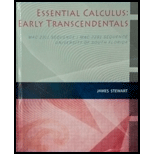
Essential Calculus: Early Transcendentals; MAC 2311 Sequence| MAC 2281Sequence USF (Essential Calculus)
2nd Edition
ISBN: 9781285101552
Author: James Stewart
Publisher: Cenage
expand_more
expand_more
format_list_bulleted
Concept explainers
Question
Chapter C, Problem 9E
To determine
To prove: The law of exponents (ab)x=axbx.
Expert Solution & Answer
Trending nowThis is a popular solution!

Students have asked these similar questions
Find the indefinite integral.
Check
Answer:
In(5x)
dx
x
Find the indefinite integral.
Check
Answer:
7x
4 + 1x
dx
Here is a region R in Quadrant I.
y 2.0 T
1.5
1.0
0.5
0.0 +
55
0.0 0.5
1.0
1.5
2.0
X
It is bounded by y = x¹/3, y = 1, and x = 0.
We want to evaluate this double integral.
ONLY ONE order of integration will work.
Good luck!
The
dA =???
Chapter C Solutions
Essential Calculus: Early Transcendentals; MAC 2311 Sequence| MAC 2281Sequence USF (Essential Calculus)
Knowledge Booster
Learn more about
Need a deep-dive on the concept behind this application? Look no further. Learn more about this topic, calculus and related others by exploring similar questions and additional content below.Similar questions
- 43–46. Directions of change Consider the following functions f and points P. Sketch the xy-plane showing P and the level curve through P. Indicate (as in Figure 15.52) the directions of maximum increase, maximum decrease, and no change for f. ■ 45. f(x, y) = x² + xy + y² + 7; P(−3, 3)arrow_forwardEX-let d'be ametric on a vector space X induced from a norm hx and d defind by a Slab)= {od (a, if a = b (a,b)+is ab Show that cannot be induced froman norm on X. 2) let à be trivel metric show that I cannot be induced from an norm on X- 3) let M be closed subspace of anormed spacex Construct the space X/Mas a normed space. 4) let Mix be vector space of 2x3 matrices on R write with Prove convex set and hyper Plane of M 5) show that every a finite dimension subspace of anormed space is closed.arrow_forwardplease do #48arrow_forward
- 43–46. Directions of change Consider the following functions f and points P. Sketch the xy-plane showing P and the level curve through P. Indicate (as in Figure 15.52) the directions of maximum increase, maximum decrease, and no change for f. ■ 45. f(x, y) = x² + xy + y² + 7; P(−3, 3)arrow_forwardplese do #48arrow_forward43-46. Directions of change Consider the following functions f and points P. Sketch the xy-plane showing P and the level curve through P. Indicate (as in Figure 15.52) the directions of maximum increase, maximum decrease, and no change for f. T 45. f(x, y) = x² + xy + y² + 7; P(−3, 3)arrow_forward
arrow_back_ios
SEE MORE QUESTIONS
arrow_forward_ios
Recommended textbooks for you
- Algebra & Trigonometry with Analytic GeometryAlgebraISBN:9781133382119Author:SwokowskiPublisher:Cengage

Algebra & Trigonometry with Analytic Geometry
Algebra
ISBN:9781133382119
Author:Swokowski
Publisher:Cengage
01 - What Is A Differential Equation in Calculus? Learn to Solve Ordinary Differential Equations.; Author: Math and Science;https://www.youtube.com/watch?v=K80YEHQpx9g;License: Standard YouTube License, CC-BY
Higher Order Differential Equation with constant coefficient (GATE) (Part 1) l GATE 2018; Author: GATE Lectures by Dishank;https://www.youtube.com/watch?v=ODxP7BbqAjA;License: Standard YouTube License, CC-BY
Solution of Differential Equations and Initial Value Problems; Author: Jefril Amboy;https://www.youtube.com/watch?v=Q68sk7XS-dc;License: Standard YouTube License, CC-BY